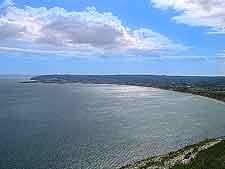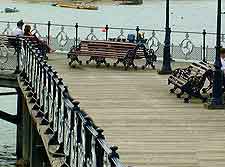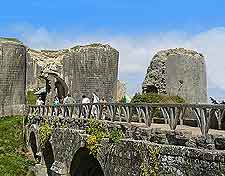Swanage History Facts and Timeline
(Swanage, Dorset, England)

Evidence of human settlement in the Swanage area dates back as far as 6000 BC and ancient burial mounds have been discovered around nearby Corfe Castle. However, it wasn't until 877 AD, that evidence of Swanage's existence first appeared in written form.
The Anglo Saxon Chronicle noted that there was an ancient Mill House and Pond here. It also stated that Swanage was the venue for a great victory by King Alfred the Great over the Danes, with some 120 Danish ships wrecked off the coast.
Early History
From the 12th century, demand for local Purbeck stone grew, particularly for use in building large churches and cathedrals. For centuries, the stone trade was to be the main industry in Swanage. In 1300, a medieval manor house was built at Godlingston in Swanage.
It was the 17th century that saw the greatest change in Swanage's history. Following the Great Fire of London of 1666, there was a huge increase in demand for Purbeck stone. It made more economic sense to load the stone directly onto ships from Swanage rather than nearby Poole. In 1701, Thomas Chapman built a Manor House at Swanage. It later became the Manor House Hotel and then the Royal Victoria Hotel.

A Victorian Seaside Resort
Until the early 19th century, Swanage was still very much connected with quarrying and fishing. However, its reputation as a seaside resort quickly rose. In 1823, a road was built along the seafront. A decade later, the young Princess Victoria was reported to have stayed in Swanage, albeit for just one night.
As the 19th century progressed, the town achieved even greater prominence. Local construction company owner John Mowlem used local stone in many of London's monuments. In 1843, another influential businessman, George Burt, built Swanage Town Hall. Together, they did much to develop the town's facilities, including Swanage railway station. For many years, there had been attempts to extend the line from Wareham to Swanage, all of which had been thwarted. Eventually, George Burt prevailed and the first public train left here in May 1885.
For the remainder of the 19th century, Swanage enjoyed its reputation as a popular seaside resort. Shops opened on the High Street, offering souvenir gifts and trinkets to visitors. In 1889, the Grand Hotel was built overlooking the bay. Then, in 1897, Swanage's new pier was opened to the public. A pier already existed, dating back to 1860 and used for transporting stone. After the introduction of pleasure steamers between Swanage,
Bournemouth and
Poole in 1874, it became clear that a new pier was needed to cope with the extra traffic.

20th Century Swanage
During World War Two, Swanage Pier was blown up to avoid it being used during an invasion. After the war, the pier was revived so that it could be used by steamer ships again. However, in 1966, the last steamer departed from Swanage and the pier was left to fall into disuse. It wasn't until 1994 that a group of residents decided to embark on a project to restore it to its former glory.
Similarly, Swanage's railway line was closed in 1972 as part of a national scheme of cutbacks. In 1975, a group of local railway enthusiasts undertook to restore the track and, in 2002, they finally succeeded in reconnecting Swanage and Wareham by rail.
 Evidence of human settlement in the Swanage area dates back as far as 6000 BC and ancient burial mounds have been discovered around nearby Corfe Castle. However, it wasn't until 877 AD, that evidence of Swanage's existence first appeared in written form.
Evidence of human settlement in the Swanage area dates back as far as 6000 BC and ancient burial mounds have been discovered around nearby Corfe Castle. However, it wasn't until 877 AD, that evidence of Swanage's existence first appeared in written form.
